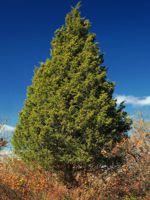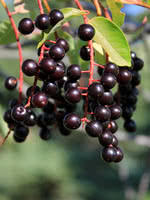Mon-Fri 9am - 5pm Mountain time
Western Chokecherry vs Eastern Red Cedar
Juniperus virginiana
Prunus virginiana var. demissa
NOT AVAILABLE THIS SEASON - MIGHT RETURN
SOLD OUT
Eastern Red Cedar is native to eastern Canada and is actually a variety of juniper, not cedar. Its pyramidal crown, low hanging branches, and dense, compact foliage makes it an ideal windbreak or shelterbelt tree.
Eastern Red Cedar will attract wildlife to your yard and provide food and shelter for multiple varieties of birds. If you are on the east coast looking to create a windbreak, consider Eastern Red Cedar.
Western Chokecherry is a shrub or small tree commonly used for farmstead and field windbreaks.
It produces white flowers in the spring and edible dark purple fruit that matures between September and October. Its cherries are great for making for making jams, jellies or wine, but are not very palatable for raw eating.
Eastern Red Cedar Quick Facts
Western Chokecherry Quick Facts
Toxicity: toxic to horses, cattle, etc.)

